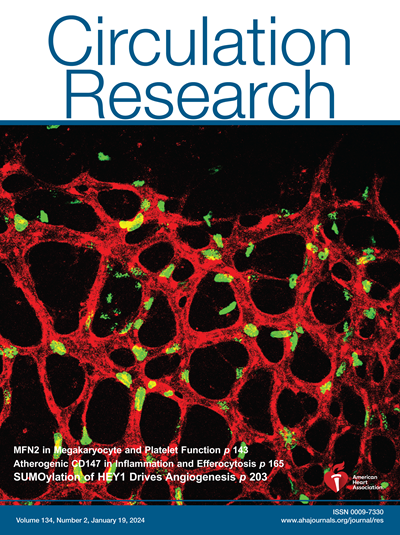不宁腿综合征,周期性腿部运动,高血压和心血管疾病。
IF 16.2
1区 医学
Q1 CARDIAC & CARDIOVASCULAR SYSTEMS
引用次数: 0
摘要
不宁腿综合征(RLS)是一种常见的与睡眠相关的感觉运动障碍,其特征是在晚上休息时急于移动腿部。严重的RLS症状会对睡眠、情绪和生活质量产生负面影响。60% - 80%的RLS患者在睡眠和清醒时都有周期性的腿部运动。RLS和周期性腿部运动的病理生理机制仍然知之甚少,涉及脑铁缺乏、多巴胺失调和遗传易感性。在过去的几十年里,一些横断面和纵向研究已经报道了RLS、心血管疾病和高血压之间的关联,尽管这些关联的程度、方向和潜在机制仍然没有定论。睡眠期间的周期性腿部运动伴随着血压和心率的升高,这可能影响夜间的生理血压下降,因此,导致心血管疾病的发病率增加。与感觉不适相关的失眠和睡眠不足也会增加交感神经张力,从而增加患心血管疾病的风险。合并症和相关的睡眠障碍也可能协同增加心血管风险。本文详细介绍了RLS(一种仍未被充分诊断和认识的疾病)的现有知识,并探讨了RLS、心血管疾病和高血压之间的流行病学关系,这种关联的潜在机制,以及降低中重度RLS患者心血管疾病风险的策略。心脏病专家和睡眠专家之间需要更多的多学科合作,以更好地识别、理解和管理睡眠障碍患者,包括睡眠倒睡症患者。本文章由计算机程序翻译,如有差异,请以英文原文为准。
Restless Legs Syndrome, Periodic Leg Movements, Hypertension and Cardiovascular Diseases.
Restless legs syndrome (RLS) is a frequent sleep-related sensorimotor disorder defined by an urge to move the legs in the evening while resting. Severe RLS symptoms can negatively impact sleep, mood, and quality of life. Periodic leg movements during sleep and wakefulness are found in 60% to 80% of patients with RLS. The pathophysiology of RLS and periodic leg movement is still poorly understood and involves brain iron deficiency, dopamine dysregulation, and genetic predisposition. Over the past decades, several cross-sectional and longitudinal studies have reported an association between RLS, cardiovascular disease, and hypertension although the magnitude, direction, and underlying mechanisms of these associations remain inconclusive. Periodic leg movements during sleep are concomitant with an increase in blood pressure and heart rate, which may affect the physiological nocturnal blood pressure dip and, therefore, lead to an increased incidence of cardiovascular disease. Insomnia and sleep deprivation linked to sensory discomfort could also increase the sympathetic tone and contribute to an increase in cardiovascular risk. Comorbidities and associated sleep disorders may also synergically increase cardiovascular risk. This narrative review details the current knowledge of RLS, a still underdiagnosed and poorly recognized disorder, and examines the epidemiological relationship between RLS, cardiovascular disease and hypertension, potential mechanisms underlying this association, and strategies to reduce the risk of cardiovascular disease in patients with moderate-to-severe RLS. Greater multidisciplinary collaborations between cardiologists and sleep specialists are needed to better identify, understand, and manage patients with sleep disorders, including those with RLS.
求助全文
通过发布文献求助,成功后即可免费获取论文全文。
去求助
来源期刊

Circulation research
医学-外周血管病
CiteScore
29.60
自引率
2.00%
发文量
535
审稿时长
3-6 weeks
期刊介绍:
Circulation Research is a peer-reviewed journal that serves as a forum for the highest quality research in basic cardiovascular biology. The journal publishes studies that utilize state-of-the-art approaches to investigate mechanisms of human disease, as well as translational and clinical research that provide fundamental insights into the basis of disease and the mechanism of therapies.
Circulation Research has a broad audience that includes clinical and academic cardiologists, basic cardiovascular scientists, physiologists, cellular and molecular biologists, and cardiovascular pharmacologists. The journal aims to advance the understanding of cardiovascular biology and disease by disseminating cutting-edge research to these diverse communities.
In terms of indexing, Circulation Research is included in several prominent scientific databases, including BIOSIS, CAB Abstracts, Chemical Abstracts, Current Contents, EMBASE, and MEDLINE. This ensures that the journal's articles are easily discoverable and accessible to researchers in the field.
Overall, Circulation Research is a reputable publication that attracts high-quality research and provides a platform for the dissemination of important findings in basic cardiovascular biology and its translational and clinical applications.
 求助内容:
求助内容: 应助结果提醒方式:
应助结果提醒方式:


